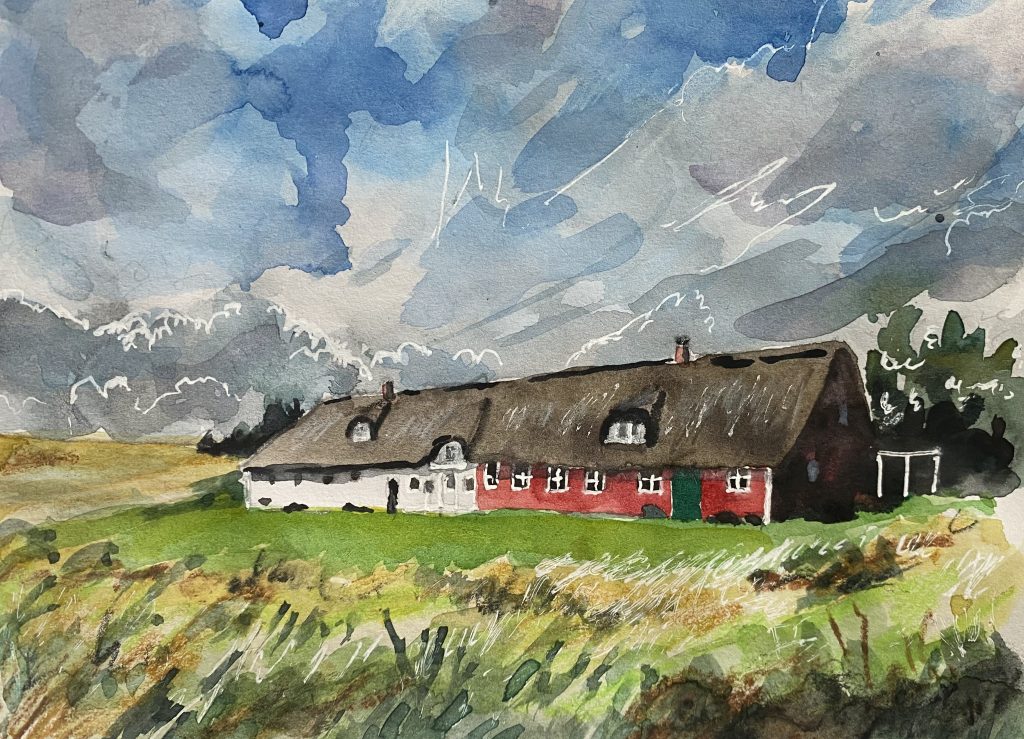
Just home from an inspiring and relaxing ten days exploring the Danish island of Fanø.
I’d never heard of this place until I read “A Scandinavian Summer” by Helga Jensen, a lovely novel about a woman who finds freedom and new love on an island where everyone rides bicycles instead of driving and thrives on friendliness, fresh air and beautiful nature.
I contacted the author, who confirmed the island was a truly wonderful place and that she had thoroughly enjoyed visiting it and researching her book.
A short flight
It takes just over an hour to fly to Billund from Heathrow, then a short hour on a bus to Esbjerg, passing Legoland as you leave the airport. A twelve minute ride on a ferry takes you across the small sleeve of sea between the mainland and Fanø. The ferry service is remarkably efficient, with three ships, each taking a small number of cars from 5 am till midnight.
Mind you, as it says in the visitor’s book, you might as well leave your car on the mainland as everything and everyone on the island is geared up for cycling. It does help that the island is almost completely flat and only 13 km long and 2km wide!
a writer’s paradise
I came here inspired by Helga Jensen’s story, but I left with two ideas for stories of my own and my sketchbook pictures will give you and idea of the two strands of its history that fascinated me, as well as some reasons for travelling there just for the lovely lifestyle.
On our first day we walked across pastureland bathed in golden light where three wind turbines
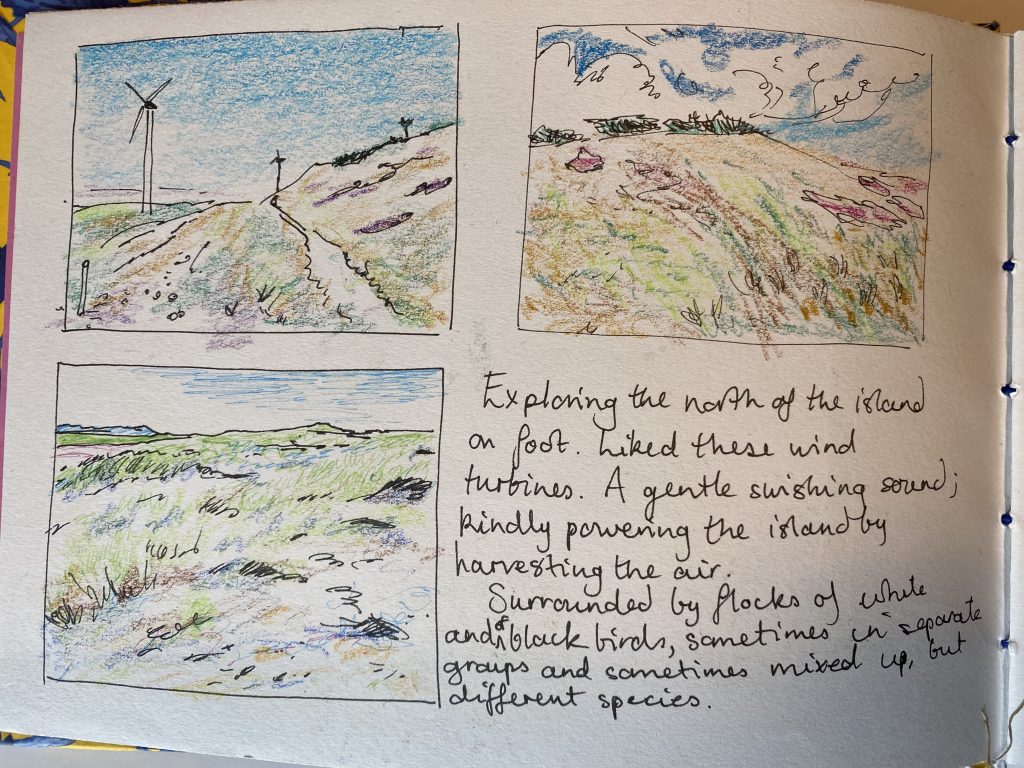
were quietly turning air into electricity to power the whole island. Flocks of birds, some black, some white, swooped around their tall, white stems and skimmed across long grass and wild flowers. We returned through what I would describe as a “Gruffalo Wood” in the style of Julia Donaldson’s children’s story
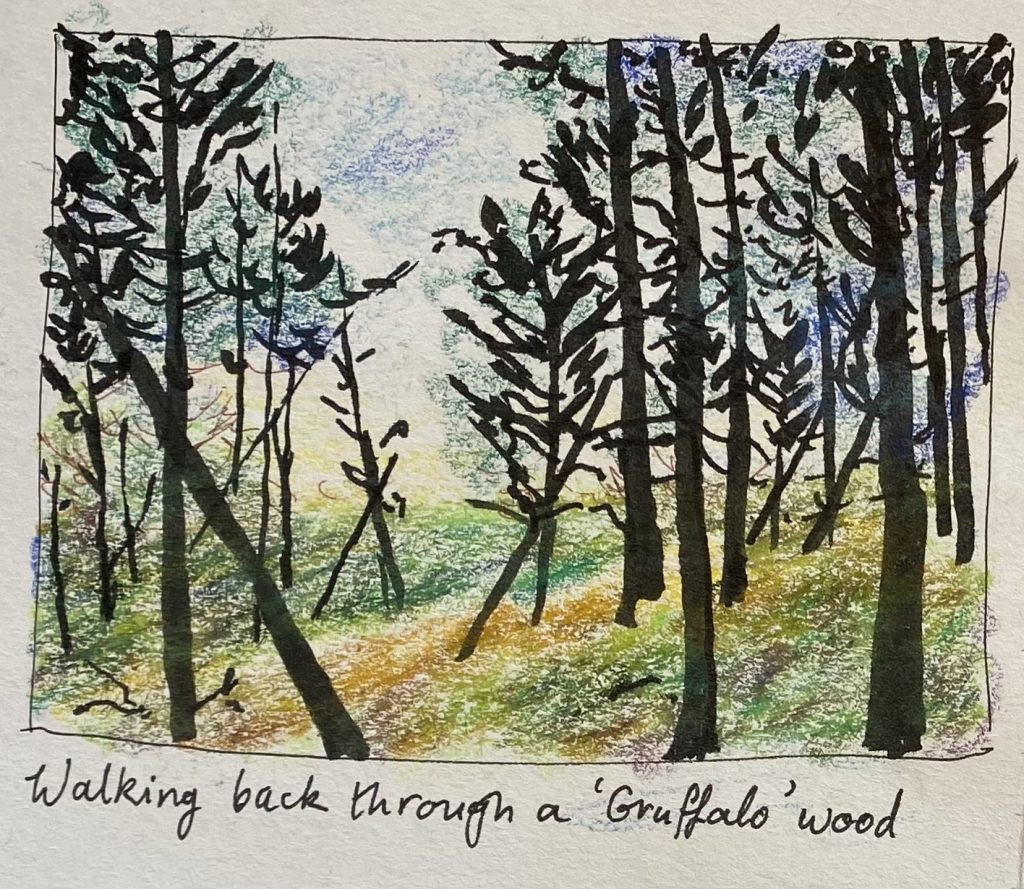
over 300 WW2 bunkers
In 1945, fearing an Allied invasion, Hitler launched a massive campaign to build thousands of concrete bunkers around Denmark. In its prominent position along the coast, directly opposite the Scottish coastline and alongside the important strategic town of Esbjerg, Fanø was considered especially vulnerable. Over 300 bunkers were rapidly sunk into its many sand dunes; equipped with men and guns and further protected by anti tank defences, barbed wire and minefields. The latter were removed after the end of the war but it was deemed too expensive to remove the concrete bolt holes and they were left as they were, minus guns, men and ammunition and left to sink further into the sand. The many that remain can be freely explored by foot. It is strangely uncanny; all too easy to feel yourself in the shoes of the men who once stood in them, peering through the narrow slits out towards Britain, cramped, probably at times bored, at others frightened and maybe longing to go back home or perhaps glad to have escaped difficult home lives and preferring to risk battle for comradeship and glory.
Here are some of the images I captured in my sketchbook, trying to get across the landscape of sand dunes peppered by brutal concrete structures and the stark entrances and emptied gun towers.
Many are covered in graffiti, usually colourful and carefully done, as if trying to soften the ugly memories they hold.

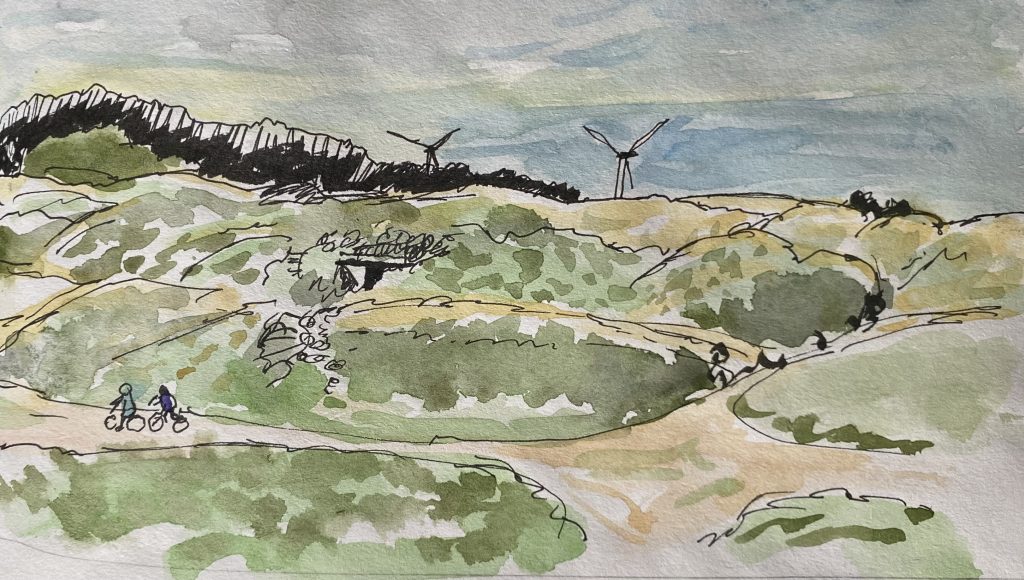
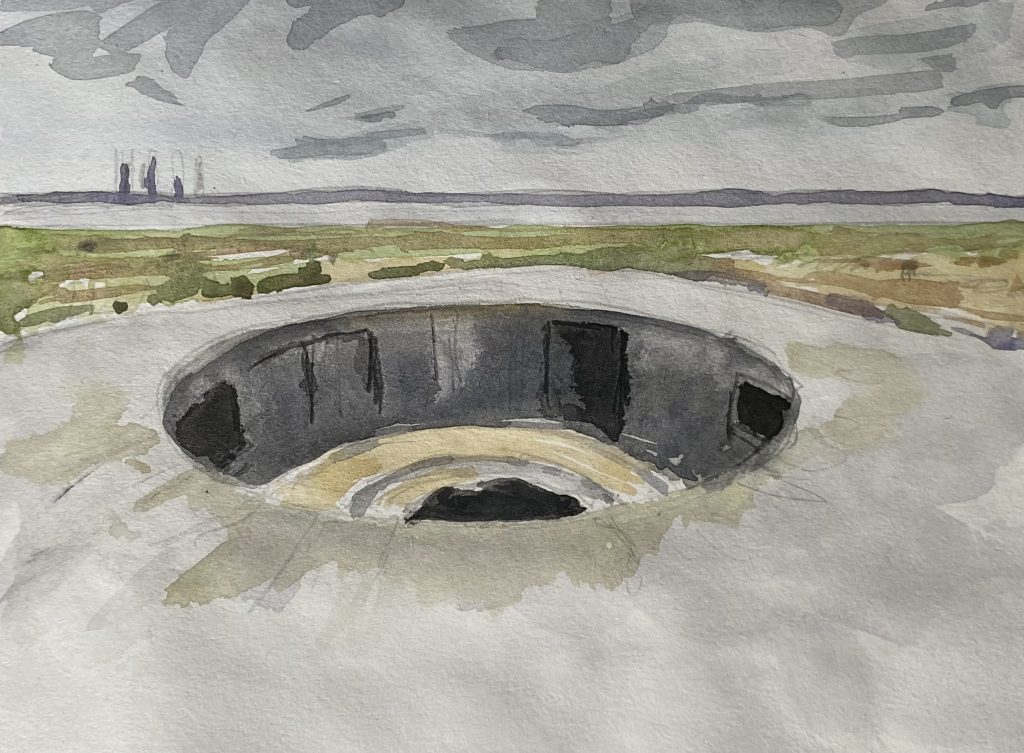
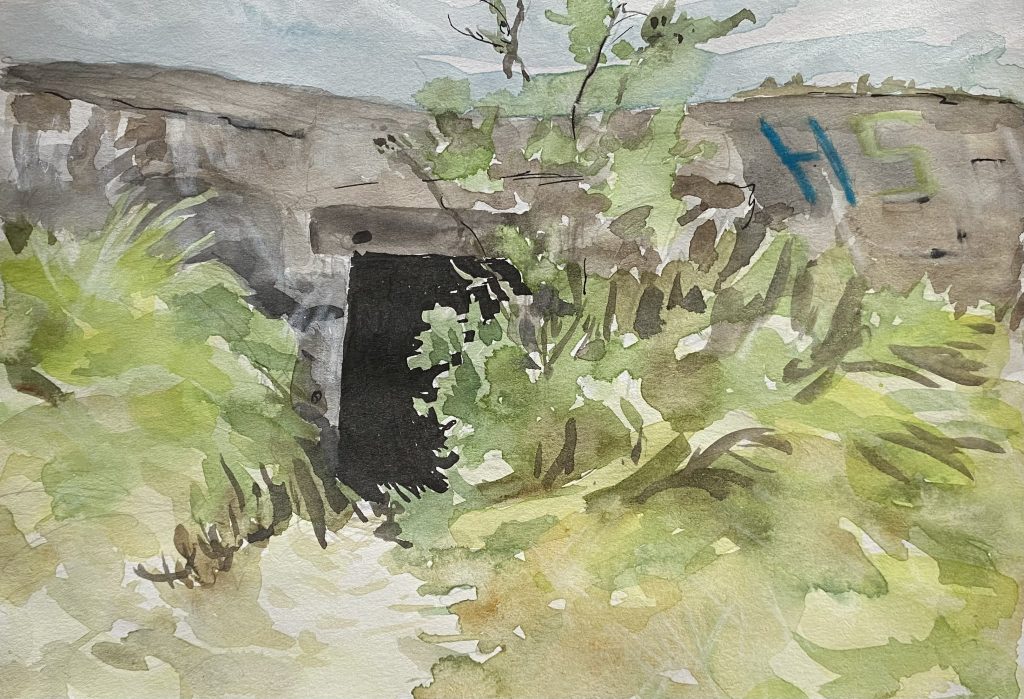
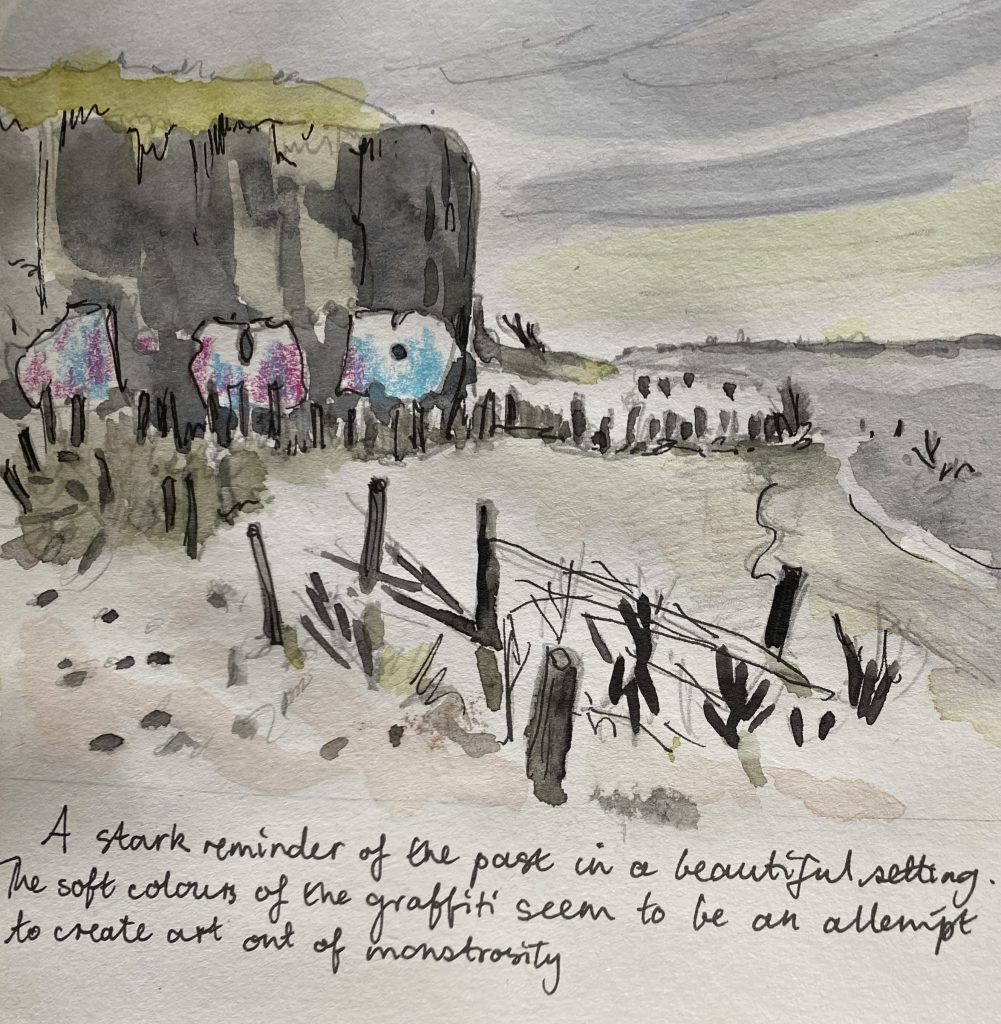
Martin and I were both fascinated by the history behind the bunkers and as well as cycling to the other sites on the island with more clusters of them we also took a trip over to Esbjerg where a fascinating museum, with its own actual bunker just where the Germans left it, explains in detail and with reconstructed features, how they were made and organised.
The same museum also had an aquarium and a really excellent outdoor museum of the history of shipbuilding in the area.
Understandably, in a modern romance, Helga Jensen had not referred to either the WW2 sites or the shipbuilding past glories of Fanø, and both these strands were a revelation to me.
new inspiration
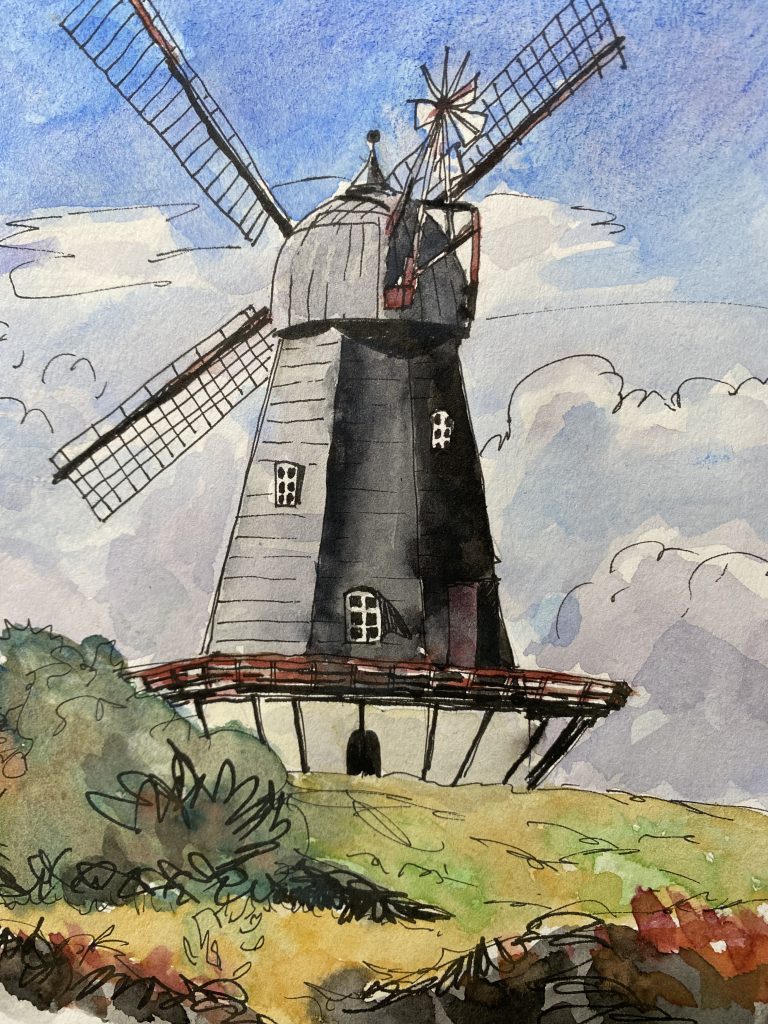
Cycling down to the second ‘town’ on the island we passed an old fashioned windmill. Compared to the chic, slender wind turbines of today this looked very heavy and clunky, but it was beautifully restored and a clear reminder of times past.

Sonderhø, that small red blob at the bottom of this map, was once a large shipbuilding centre until the spreading of sandbars made it too dangerous for ships to sail into the Wadden Sea.
Like its northern ‘sister’, Nordby, this settlement is composed of many beautiful thatched houses in the traditional style; low and long in stature and almost all built East-West; their smallest walls against the freezing west winds of winter. Within the coldest room they would stable their animals as an extra layer of insulation. With few trees on the island, fuel for stoves was scarce and families resorted to burning cow pats or had to collect driftwood or import wood from the mainland to help them survive.
I was fascinated by the stories of life in the nineteenth century when the shipbuilding industry was at its peak and almost all the young adult males were involved in making boats or sailing them for fishing or commerce. Far from being an obscure, unconnected corner of the world, this was a place where family members returned from long trips abroad with tall tales of their adventures and gifts such as parrots from Australia, tableware from China, and monkeys from Asia.
Meanwhile, the women were left to raise the children, keep the family home maintained, provide food, raise animals and run the island. Although there was little or no schooling the range of skills and scientific knowledge they possessed was extraordinary and their craft work showed just what people can achieve when they don’t have the option of watching tv or scrolling on their phones in the evenings!
A short, tough but extraordinary Life
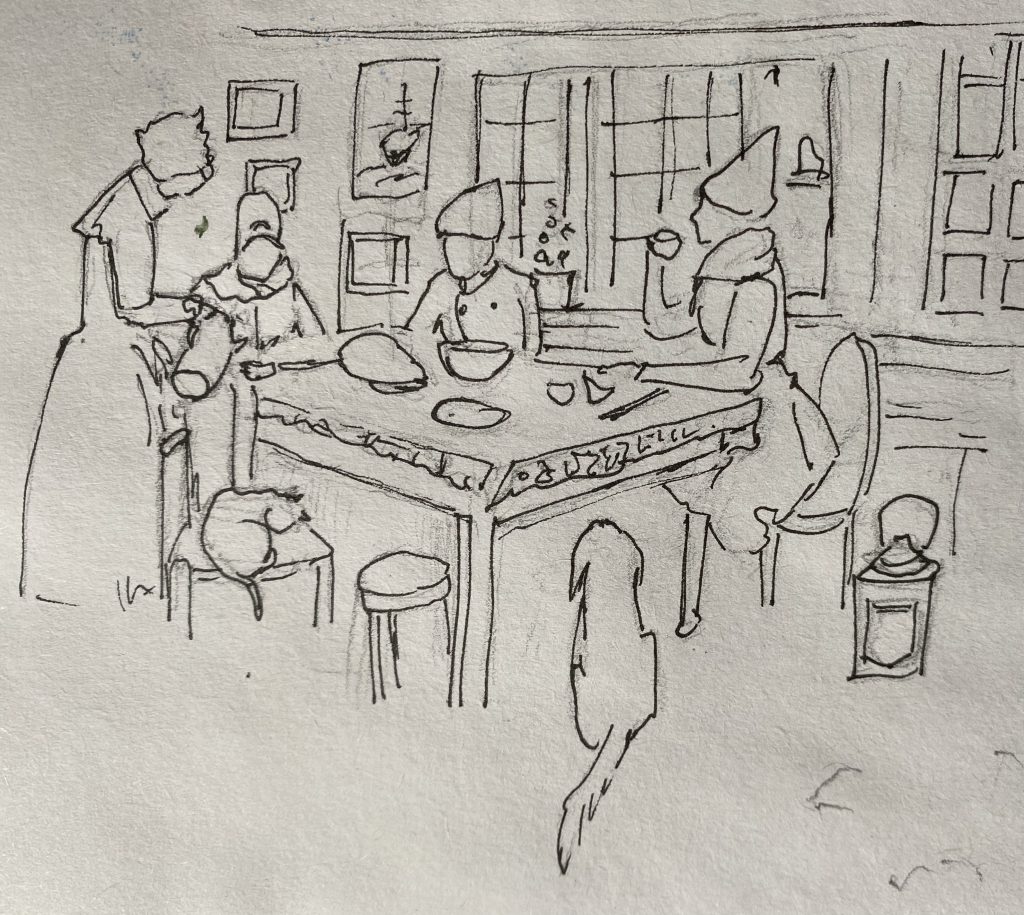
The Fanø museum in Nordby was a great source of information, articles and photographs of the late Victorian and early twentieth century people on the island and I felt a strong urge to create a story of a family living in the 1890s, just before the end of the ship building era. So now I began using my sketchbook to blend historical sources with imagination, trying as far as possible to glean details of what people wore, how they lived and what would have been important to them.
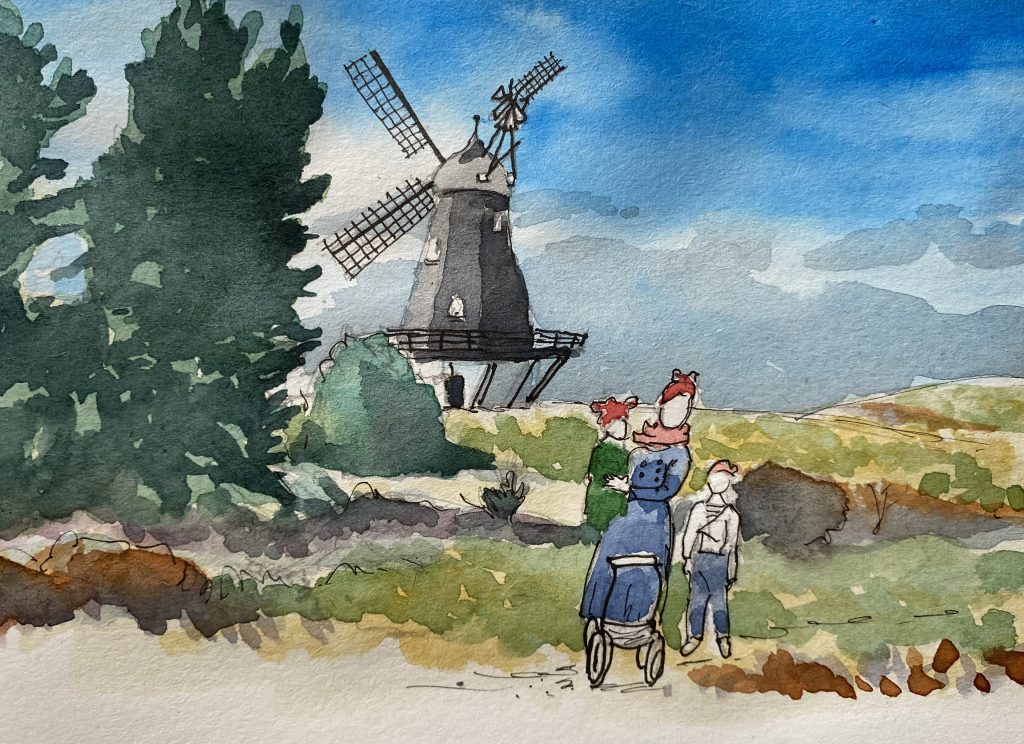
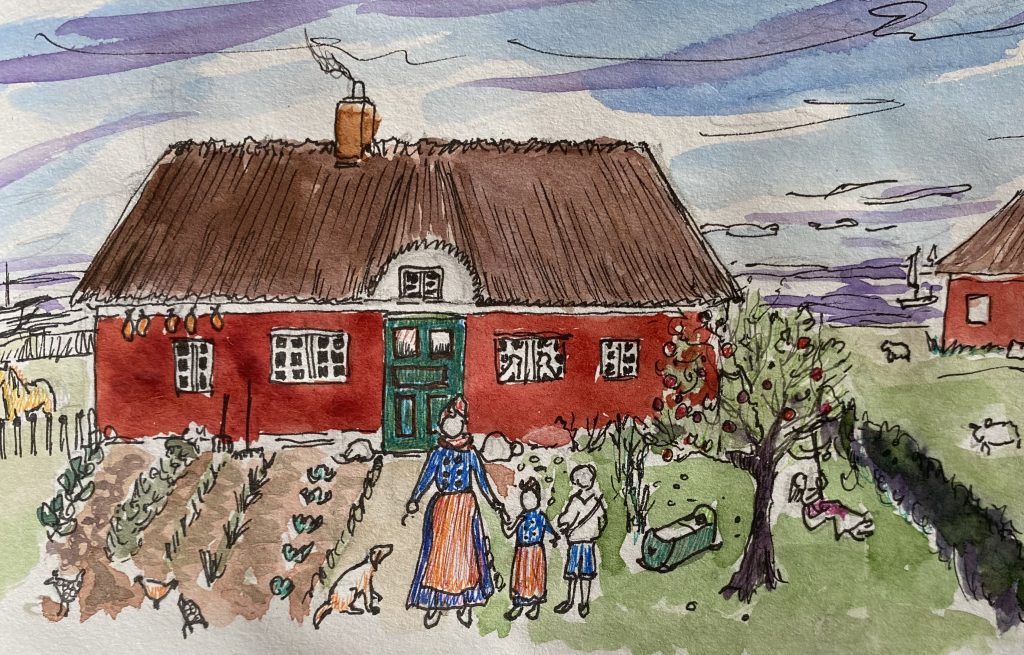
and finally
It wasn’t just about history, though! Our trusty hired ‘sit up and beg’ style bikes took us over to the beach on the west coast. This is a strip of silver sand running the entire length of Fanø. In the central part there is a strip reserved for racing buggies powered by the wind. Against a colourful backdrop of static kites and breaking waves, braver souls than me fly along the firm sand runway in lightweight craft either powered by an integrated sail or literally pulled along by giant kites.
This was a great opportunity to use the full width of my hand made sketchbook to create a panorama.
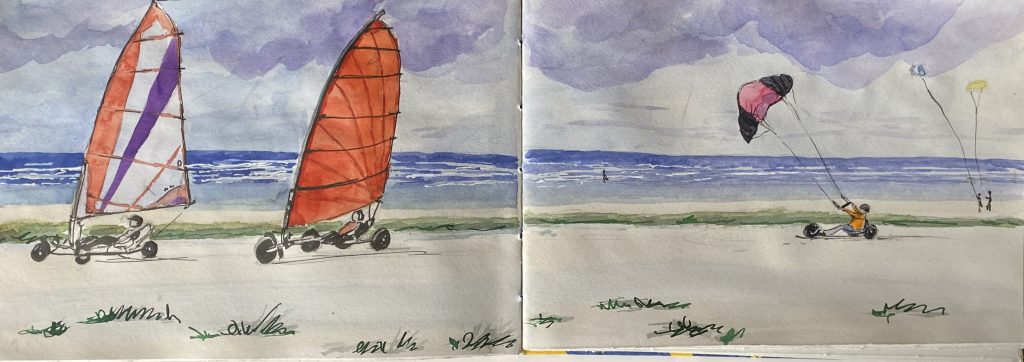
On the whole the handmade sketchbook with its recycled paper was excellent for the purpose of holiday sketching, but I’ve just ordered some large size watercolour paper for future books so I can create more books that are exactly the size and orientation I want and will take a slightly wetter watercolour without buckling. Looking forward to getting stitching!
cafe culture
There are many other lovely things to recommend this special place, including its food and drink and friendly cafe life. We were particularly fond of the “Haven” , where we could sit in a relaxing garden with a nice view of the gently bustling high street and admire its thatched roof and pretty flowers.
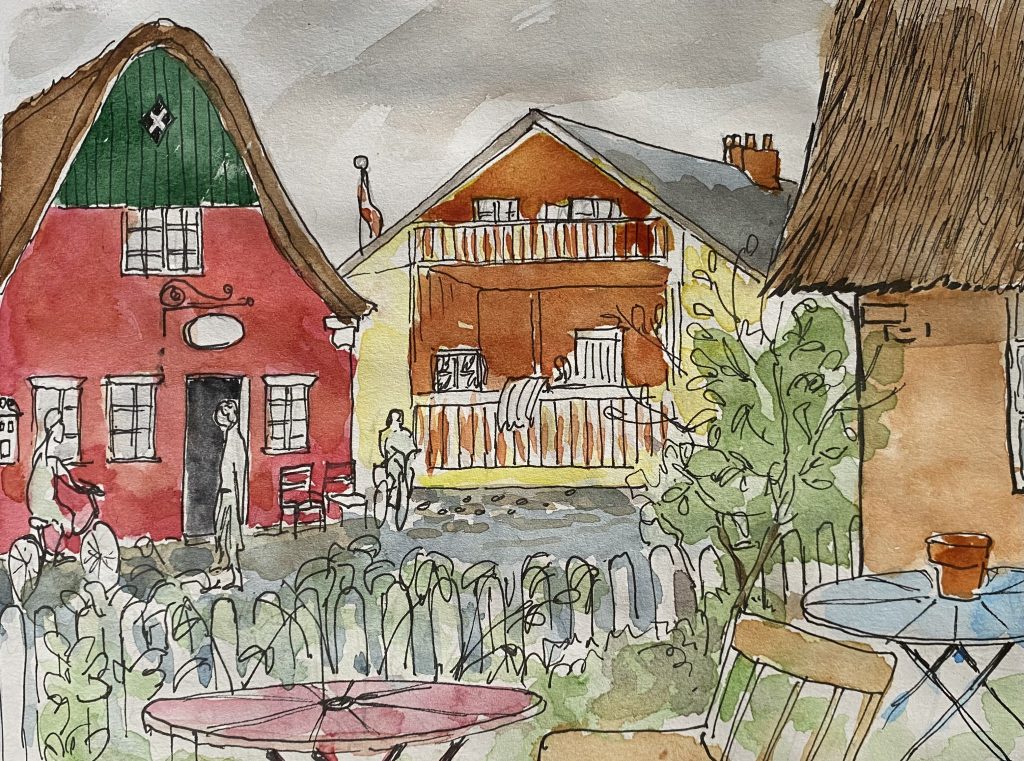
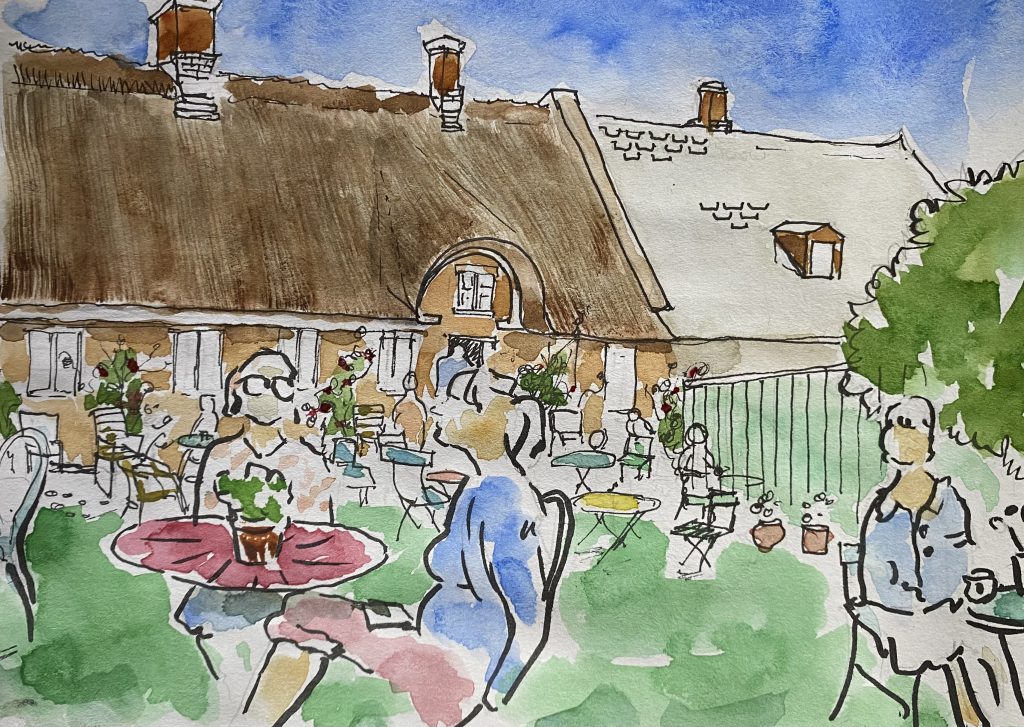
If anyone reading this is interested in making their own bespoke sketchbooks or in getting tips on what what art materials to take on holiday and how to get the most from your travel journals you might be interested in some of the courses listed in the ‘Events’ section.

Dear Sarah
I enjoyed your storytelling, your beautiful sketches and Im so glad that you enjoyed a relaxing moment in HAVEN.
Beautiful 🌸🩷
Kindness
Camilla
Hi Camilla
Thank you so much. We visited ‘Haven’ several times! Lovely place 😊